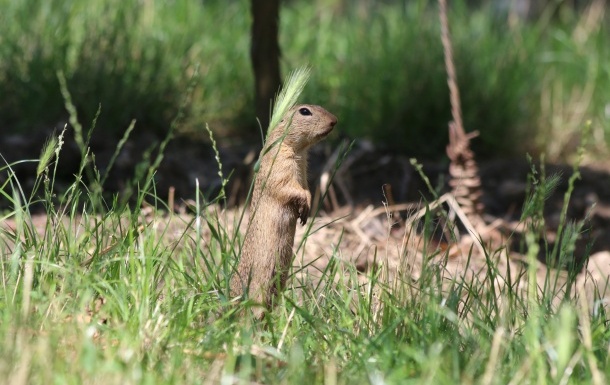What can you do for sousliks in your vineyard?

Ultimately, the main reason why sousliks may or may not be present in your vineyard is influenced by the way your vineyard is cultivated. Here is some advice and suggestions on how you can ensure your vineyard is a suitable environment for this critically endangered species.
This advice is suitable for:
- Winegrowers who want to protect the sousliks which already live their vineyard
- Winegrowers who want to attract sousliks to their vineyard.
As the number of vineyards with sousliks is very small, there is always a risk that they might disappear from these areas completely. It is therefore vital for us to try and protect this endangered species and their preferred environments. You can help us do this, they deserve it! And one comment to those sceptical about having sousliks in your vineyards, sousliks won’t interfere with your crops! Read more here about why that is so.
Please contact us if you have seen sousliks in your vineyard or to find out there have been any reports of sousliks in your area, currently there are only a few areas!
GRASS
To be awarded the Sysli na vinici trademark, you will have to keep at least every other row in your vineyard grassy. The optimum would be, of course, to have grass all over your vineyard. Now, having grass is the first step, the next is to ensure the suitability of your grass.
LET YOUR GRASS GROW!
The height of your grass is fundamental to the survival of sousliks. Too short, the sousliks won’t be able to hide from predators but too high and they won’t be able to see them coming! They are constantly looking around and watching their surroundings so grass of around 15cm is about right. The number of times you need to mow depends on your soil productivity and rainfall in the year, but normally around three times per year is sufficient. If you have other animals such livestock, you could always use them to graze your vineyard as well.
Avoid using rodenticides
All rodenticides, poisonous chemicals used for rodent control, are very harmful to sousliks - sousliks are rodents as well! Whilst you can prevent harm coming to the sousliks by not using rodenticides in your vineyard, the problem still exists if rodenticides are used in your local environment such as neighbouring gardens. If you or your neighbours are using, or thinking of using rodenticides, if necessary, we advise you to only use them in the winter. We suggest this as sousliks spend the winter months hibernating therefore might not be negatively affected by the use of rodenticides during this time. If in doubt, we advise to not use them at all.
Nutritional sources of food
Sousliks feed on various parts of plants such as leaves, seeds and even the roots. You can help the sousliks by sowing a variety of plants in your vineyards which are highly calorific. This way, the sousliks have the opportunity to put on more weight before their winter hibernation and have a higher chance of surviving the cold months. This means we help them to prepare for when spring comes and raising their new young. Plants such as corn or alfalfa are easy to maintain in your vineyard and great source of food for the sousliks. Also, part of the sousliks diet consists of fallen fruits from different species of trees such as apples, plums, apricots and even nuts. If you are planning to plant any trees in your vineyard, remember the sousliks! Sousliks start hibernating as early as September so try and plant trees which ripen earlier in the year to help your sousliks.
Linking vineyards
Not everywhere in the wine-growing region is suitable for sousliks. Areas between vineyards where it is overgrown, sloped, there are dense bushes or open fields are not very suitable for the sousliks. We must, therefore, try to connect the current, isolated colonies of sousliks. Creating suitable belts between these areas is one method to help the sousliks. Another method could be to the maintain grassy paths between these areas.
Feeding
If in the spring months, especially May and June, there are a few days of colder, rainy weather, it may be that the females are not able to care for their newborn. These are critical days for the survival of the species and you can help them putting out extra food for them. Sprinkling sunflower seeds, oats, barley or fruit pieces such as apple close to the burrows can help them through these harder days.





